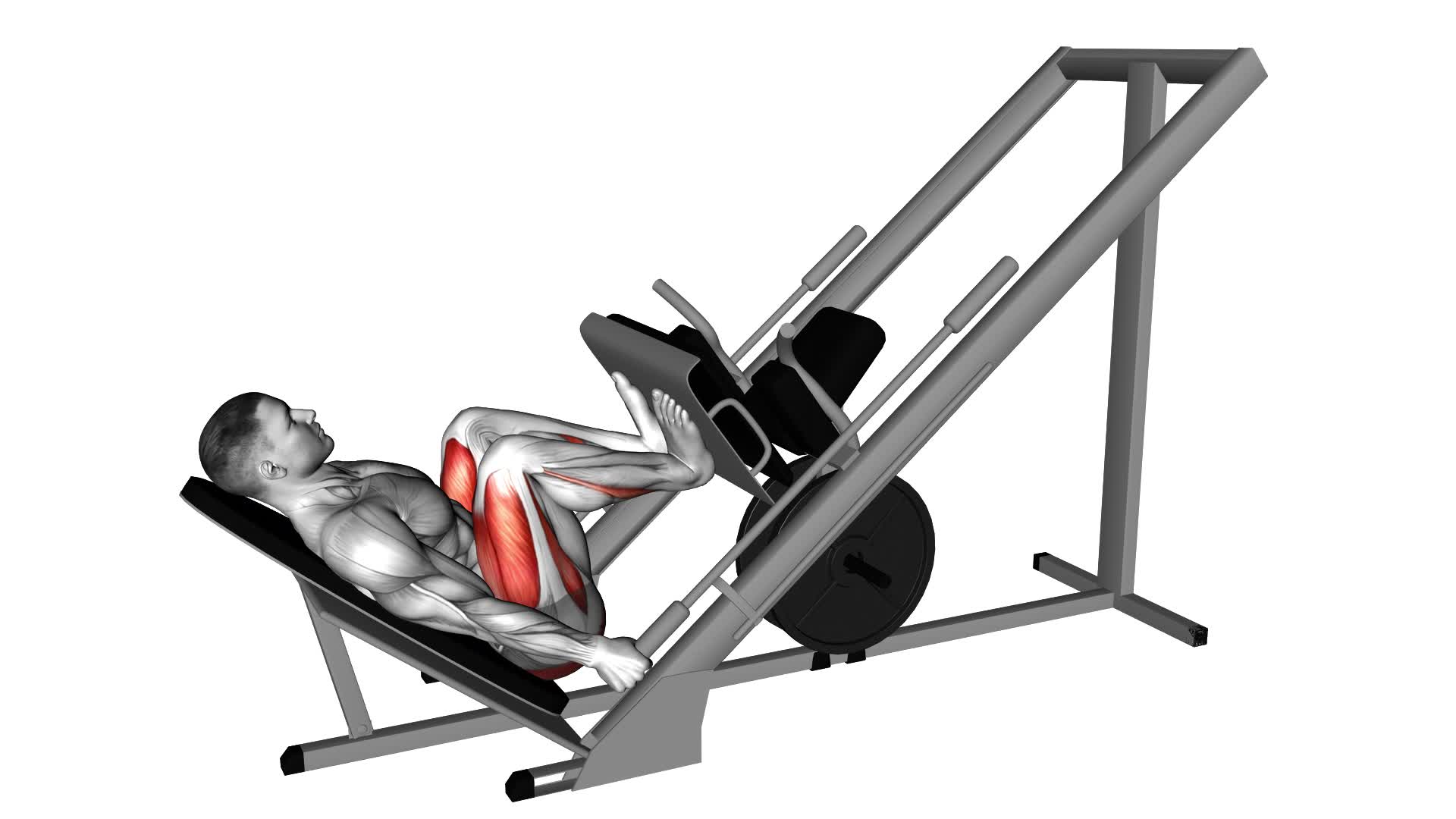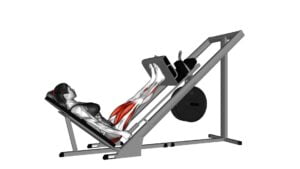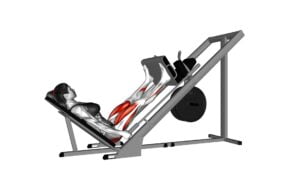Sled Narrow Stance Leg Press – Video Exercise Guide & Tips

Are you looking to strengthen your legs and improve your lower body strength? Look no further than the Sled Narrow Stance Leg Press.
Watch This Exercise Video
This exercise targets your quads, hamstrings, and glutes, helping you build muscle and increase power.
In this video exercise guide, we'll show you the proper form and technique, as well as common mistakes to avoid.
Get ready to challenge yourself and get the most out of your leg workout with this effective exercise.
Let's get started!
Key Takeaways
- The sled narrow stance leg press targets the quads, hamstrings, and glutes.
- Proper form and technique, such as maintaining a neutral spine and aligning knees with toes, are important for maximizing the benefits of the exercise.
- Common mistakes to avoid include using too much weight, lifting hips off the seat, and not focusing on muscle contraction.
- Variations and progressions, such as single-leg sled leg press and different foot positions, can be used to challenge yourself and improve stability and explosiveness.
Benefits of the Sled Narrow Stance Leg Press
You can experience several benefits from incorporating the sled narrow stance leg press into your workout routine. This exercise is highly effective at targeting your leg muscles and promoting muscle activation. By placing your feet closer together on the sled, you engage your quadriceps, hamstrings, and glutes to a greater extent. This increased muscle activation leads to improved strength and definition in your legs.
In addition to muscle activation, the sled narrow stance leg press also enhances joint stability. The narrow stance requires greater control and balance, which helps strengthen the muscles surrounding your knees and ankles. This increased stability not only reduces the risk of injury but also improves your overall performance in other exercises and daily activities.
Transitioning to the subsequent section about proper form and technique for the exercise, it's crucial to understand that maximizing the benefits of the sled narrow stance leg press requires proper execution. By maintaining a neutral spine, keeping your knees aligned with your toes, and controlling the movement throughout, you can ensure optimal muscle activation and joint stability. So, let's delve into the details of the proper form and technique for this exercise.
Proper Form and Technique for the Exercise
To ensure proper execution of the sled narrow stance leg press, focus on maintaining a neutral spine, aligning your knees with your toes, and controlling the movement throughout. This exercise primarily targets the quadriceps, hamstrings, and glutes, but it also engages the calves and lower back muscles to a lesser extent.
One common error to avoid is rounding your back during the movement. This can put unnecessary strain on your lower back and increase the risk of injury. To maintain a neutral spine, keep your chest up and shoulders back throughout the exercise.
Another mistake to watch out for is allowing your knees to cave inward. This can place excessive stress on the knee joint and potentially lead to injury. Instead, focus on keeping your knees aligned with your toes throughout the movement.
In terms of muscle activation, the sled narrow stance leg press primarily targets the quadriceps. To maximize muscle activation, push through your heels and focus on fully extending your knees. Additionally, you can increase the range of motion by lowering the sled until your knees are at a 90-degree angle or slightly lower.
Common Mistakes to Avoid
Maintaining proper form and technique is crucial to avoid common mistakes during the sled narrow stance leg press. By understanding these common mistakes, you can ensure that you perform the exercise effectively and minimize the risk of injury.
One common mistake is using too much weight. It's important to start with a weight that you can handle comfortably and gradually increase it as you become stronger.
Another mistake to avoid is lifting your hips off the seat. This can put unnecessary strain on your lower back and reduce the effectiveness of the exercise. Make sure to keep your hips firmly planted on the seat throughout the movement.
Additionally, avoid locking your knees at the top of the movement. This can lead to joint stress and potential injury. Instead, aim to maintain a slight bend in your knees throughout the exercise.
Lastly, rushing through the movement is another common mistake. Take your time and focus on the contraction of your leg muscles as you press the sled away from your body.
Variations and Progressions to Challenge Yourself
To challenge yourself, you can incorporate variations and progressions into your sled narrow stance leg press routine. One of the sled leg press variations you can try is the single-leg sled leg press. Instead of using both legs at the same time, you'll use only one leg to push the sled. This variation not only targets your quads, hamstrings, and glutes but also engages your core for stability.
Another advanced leg press technique is the explosive sled leg press. This involves pushing the sled with maximum force and speed, generating power in your legs. This variation can help improve your explosiveness and speed for activities such as sprinting or jumping. Additionally, you can experiment with different foot positions, such as placing your feet higher or lower on the sled, to target different muscle groups.
By incorporating these sled leg press variations and advanced leg press techniques into your routine, you can continuously challenge your muscles and promote further strength and growth.
Now, let's move on to the next section where we'll provide tips for getting the most out of your leg workout.
Tips for Getting the Most Out of Your Leg Workout
Maximize your leg workout by following these tips.
To maximize muscle growth, it's important to challenge yourself with heavier weights and progressive overload. Gradually increase the weight you're using to ensure your muscles are constantly being pushed to adapt and grow stronger. However, it's crucial to prioritize proper form and technique over lifting heavy. This won't only prevent injuries but also allow you to target the muscles effectively.
Warm-up before your leg workout to increase blood flow and prepare your muscles for the exercises. This can be done through dynamic stretches or light cardio exercises.
Incorporate compound exercises like squats and lunges into your leg routine as they engage multiple muscle groups simultaneously, promoting overall muscle growth. Don't forget to include isolation exercises such as leg extensions and hamstring curls to target specific muscles and develop balanced strength.
Incorporating plyometric exercises like box jumps and jump squats can add an explosive element to your leg workout, increasing power and muscle activation. However, be cautious with plyometrics and ensure proper technique to prevent injuries.
Lastly, prioritize recovery by allowing adequate rest between workouts and scheduling rest days. This will give your muscles time to repair and grow. Remember to listen to your body and adjust your workout intensity accordingly.
Frequently Asked Questions
How Much Weight Should I Start With When Performing the Sled Narrow Stance Leg Press?
When starting the sled narrow stance leg press, it's important to find a weight that challenges you without causing strain or injury. Focus on your running performance and leg press variations to determine your starting weight.
Begin with a weight that allows you to perform the exercise with proper form and control. As you become more comfortable and stronger, gradually increase the weight to continue challenging your muscles and improving your leg press performance.
Can the Sled Narrow Stance Leg Press Help Improve My Running Performance?
To improve your running performance, the sled narrow stance leg press can be beneficial. By incorporating this exercise into your routine, you can strengthen your leg muscles, specifically targeting your quadriceps, hamstrings, and glutes.
This will help to improve your running technique, providing more power and stability. Sled training in general is known to enhance speed, agility, and overall athletic performance.
Is It Necessary to Warm up Before Doing the Sled Narrow Stance Leg Press?
Before starting the sled narrow stance leg press, it's important for you to warm up. Warming up can provide several benefits, such as increasing blood flow to your muscles and improving your range of motion. It also prepares your body for the exercise and reduces the risk of injury.
Once you're warmed up, focus on maintaining proper form and technique during the exercise to maximize its effectiveness.
Can I Do the Sled Narrow Stance Leg Press if I Have Knee or Hip Problems?
If you're dealing with knee or hip problems, it's important to consider your safety before attempting the sled narrow stance leg press. This exercise puts pressure on your knees and requires good hip mobility.
Consult with a medical professional or a certified trainer to determine if it's suitable for you. They can provide guidance and recommend alternative exercises that will be safer and more beneficial for your knee pain and hip mobility.
How Often Should I Incorporate the Sled Narrow Stance Leg Press Into My Leg Workout Routine?
To determine the leg press frequency, it's important to consider your overall leg workout routine and goals. The sled narrow stance leg press can be a great variation to incorporate, but don't overdo it. Aim to include it once or twice a week, along with other leg press variations, to keep your workouts well-rounded.
This will help target different muscle groups and prevent overuse injuries. Remember to listen to your body and adjust the frequency as needed.
Conclusion
In conclusion, the Sled Narrow Stance Leg Press is a beneficial exercise for targeting the lower body muscles. By using proper form and technique, you can maximize the effectiveness of this exercise and avoid common mistakes.
Additionally, incorporating variations and progressions can help challenge yourself and continue to see progress. Remember to always listen to your body and consult with a fitness professional for personalized guidance.

Author
Years ago, the spark of my life’s passion ignited in my mind the moment I stepped into the local gym for the first time. The inaugural bead of perspiration, the initial endeavor, the very first surge of endorphins, and a sense of pride that washed over me post-workout marked the beginning of my deep-seated interest in strength sports, fitness, and sports nutrition. This very curiosity blossomed rapidly into a profound fascination, propelling me to earn a Master’s degree in Physical Education from the Academy of Physical Education in Krakow, followed by a Sports Manager diploma from the Jagiellonian University. My journey of growth led me to gain more specialized qualifications, such as being a certified personal trainer with a focus on sports dietetics, a lifeguard, and an instructor for wellness and corrective gymnastics. Theoretical knowledge paired seamlessly with practical experience, reinforcing my belief that the transformation of individuals under my guidance was also a reflection of my personal growth. This belief holds true even today. Each day, I strive to push the boundaries and explore new realms. These realms gently elevate me to greater heights. The unique combination of passion for my field and the continuous quest for growth fuels my drive to break new ground.







